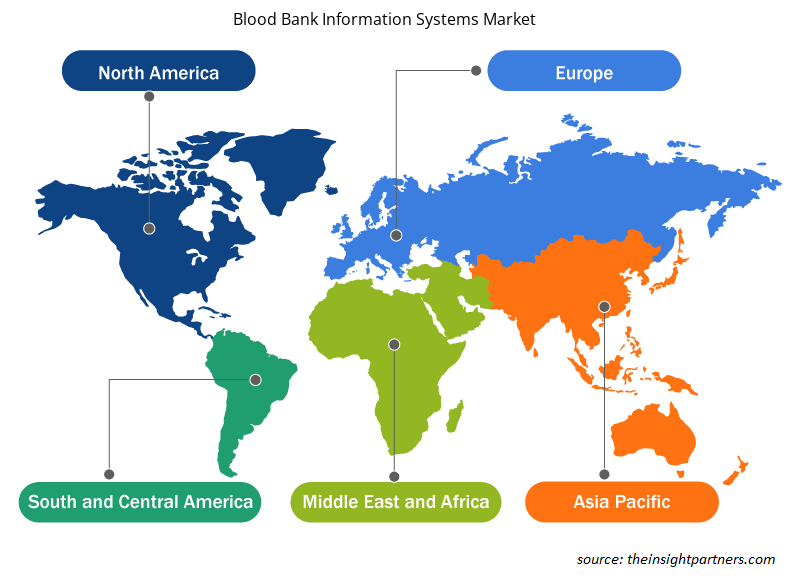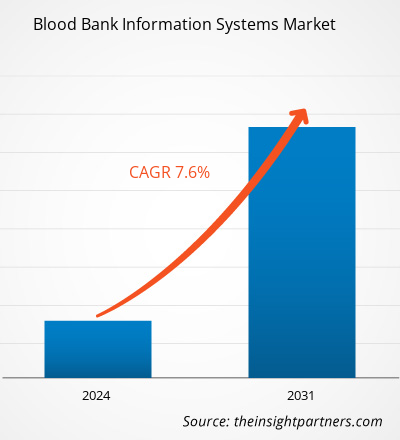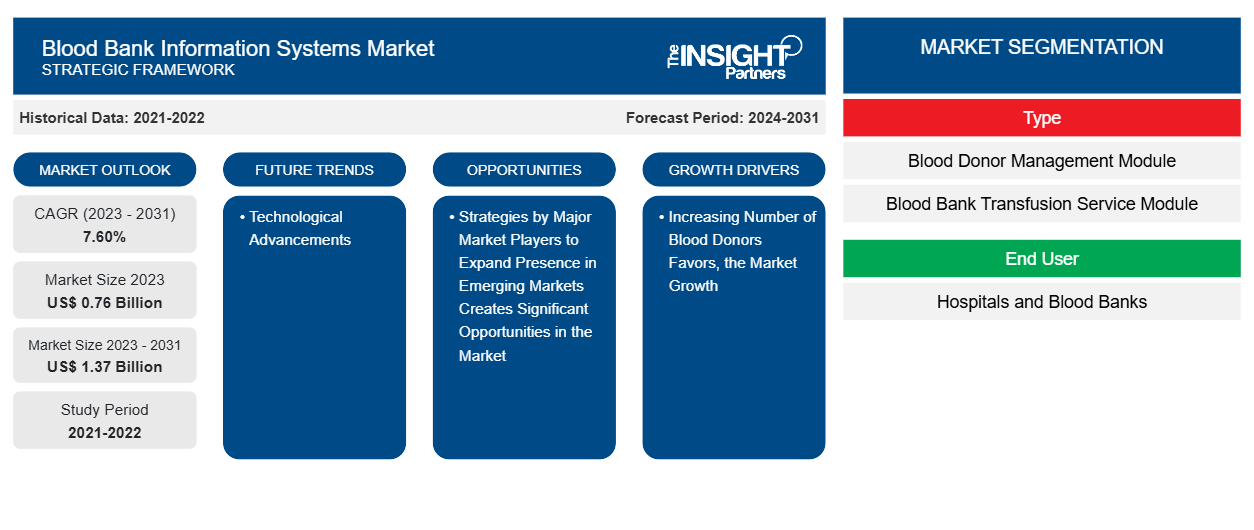Der Markt für Blutbankinformationssysteme soll von 0,76 Milliarden US-Dollar im Jahr 2023 auf 1,37 Milliarden US-Dollar im Jahr 2031 anwachsen. Für den Zeitraum 2023–2031 wird ein durchschnittliches jährliches Wachstum von 7,60 % erwartet. Der technologische Fortschritt dürfte ein wichtiger Trend auf dem Markt bleiben.CAGR of 7.60% during 2023–2031. Technological advancement is likely to remain a key trend in the market.
Marktanalyse für Blutbank-Informationssysteme
Unternehmen sind bestrebt, neue Produkte auf den Markt zu bringen, und die Ausweitung ihrer Geschäftstätigkeit durch verschiedene Methoden sollte den Markt ankurbeln. Unternehmen wie Cerner Corporation, Allscripts Healthcare, LLC, Haemonetics Corporation, WellSky, Hemosoft, Integrated Medical Systems, Soft Computer Consultants, Inc., IT Synergistics, Psyche Systems Corporation und Sunquest Information Systems, Inc. haben eine Vielzahl von Strategien umgesetzt, darunter Produkteinführungen, Produktzulassungen, Fusionen und Übernahmen sowie Marktinitiativen. So gab CliniSys im Januar 2022 bekannt, dass es kürzlich HORIZON Lab Systems übernommen und sich mit Sunquest Information Systems zu CliniSys zusammengeschlossen hat.
Marktübersicht zu Blutbank-Informationssystemen
Die weltweit zunehmende Verbreitung hämatologischer Erkrankungen treibt den Bedarf an Blutspenden in die Höhe. Laut der Leukemia and Lymphoma Society (LLS) wird in den USA alle drei Minuten bei einer Person Leukämie, Lymphom oder Myelom diagnostiziert. Darüber hinaus wurden im Jahr 2021 in den USA etwa 186.400 Fälle von Leukämie, Lymphom und Myelom gemeldet. Darüber hinaus machten Blutkrebsfälle im Jahr 2021 etwa 9,8 % der geschätzten 1.898.160 neuen Krebsfälle im Land aus. Knochenmarkzelltransplantationen und Bluttransfusionen werden aufgrund der steigenden Inzidenz von Blutkrebserkrankungen wie Leukämie immer häufiger. Das Amerikanische Rote Kreuz schätzt, dass in den USA täglich etwa 5.000 Blutplättchen, 6.500 Einheiten Plasma und etwa 29.000 Einheiten rotes Blut für verschiedene hämatologische Erkrankungen benötigt werden.
Darüber hinaus werden in den Vereinigten Staaten jährlich 16 Millionen Blutkomponenten transfundiert, um verschiedene blutbedingte Krankheiten wie Blutkrebs und andere zu behandeln. Darüber hinaus wurde berichtet, dass im Jahr 2020 über 1,8 Millionen Menschen eine Krebsdiagnose erhielten. Infolgedessen steigt der Bedarf an Bluttransfusionen aufgrund der Zunahme hämatologischer Erkrankungen, was das Wachstum des globalen Marktes für Blutbankinformationssysteme vorantreibt.
Passen Sie diesen Bericht Ihren Anforderungen an
Sie erhalten kostenlos individuelle Anpassungen an jedem Bericht, einschließlich Teilen dieses Berichts oder einer Analyse auf Länderebene, eines Excel-Datenpakets sowie tolle Angebote und Rabatte für Start-ups und Universitäten.
- Holen Sie sich die wichtigsten Markttrends aus diesem Bericht.Dieses KOSTENLOSE Beispiel umfasst eine Datenanalyse von Markttrends bis hin zu Schätzungen und Prognosen.
Markttreiber und Chancen für Blutbank-Informationssysteme
Steigende Zahl der Blutspender begünstigt das Marktwachstum
Aufgrund der zunehmenden Unfallhäufigkeit und der zunehmenden Verbreitung hämatologischer Erkrankungen steigt der weltweite Bedarf an Blut. Die Weltgesundheitsorganisation (WHO) schätzt, dass weltweit etwa 118,4 Millionen Blutkonserven gespendet werden. Davon werden 40 % in Ländern mit hohem Einkommen gesammelt. Darüber hinaus werden jährlich 106 Millionen Spenden von etwa 13.300 Blutbanken in 169 Ländern gemeldet. Darüber hinaus sind laut WHO 33 % der Blutspender weltweit weiblich.
Darüber hinaus berichtete die WHO, dass zwischen 2013 und 2018 156 Länder einen Anstieg von 7,8 Millionen freiwilligen unbezahlten Blutspenden meldeten. Die Regionen mit den stärksten Anstiegen bei freiwilligen, unbezahlten Blutspenden sind Afrika (23 %) und Amerika (25 %). Der Westpazifik meldete den stärksten Anstieg der absoluten Spendenzahlen (2,67 Millionen), gefolgt von Amerika (2,66 Millionen) und Südostasien (2,37 Millionen). Darüber hinaus machen freiwillige unbezahlte Blutspenden über 90 % der Blutversorgung in etwa 79 Ländern aus, darunter 38 Länder mit hohem Einkommen, 33 Länder mit mittlerem Einkommen und acht Länder mit niedrigem Einkommen. Darüber hinaus beziehen 62 Länder ihr Blut von freiwilligen, unbezahlten Spendern.
Darüber hinaus ist mehr als die Hälfte der weltweiten Blutversorgung – 56 Länder, neun Länder mit hohem Einkommen, 37 Länder mit mittlerem Einkommen und zehn Länder mit niedrigem Einkommen – auf bezahlte Spender und Familienspender angewiesen. Dies erhöht den weltweiten Bedarf an Blutbank-Informationssystemen. Da die Zahl der Blutspender weltweit steigt, verwalten und lagern Blutbanken Blut auf neue und innovative Weise. Blutbank-Informationssysteme werden hauptsächlich zum Sammeln von Blutspenden verwendet. So wurde beispielsweise 2020 von Samson Oloruntoba und anderen Verlagen ein Bericht über die Entwicklung eines Blutentnahmesystems zur Verwaltung von Blutspenderunterlagen und zur Regulierung der Blutverteilung in staatlichen Krankenhäusern veröffentlicht. Das System bietet Spenderunterlagen schnellen, effizienten und vertraulichen Zugriff auf medizinische Berichte. Seine Grundlage ist ein Android- und webbasiertes Blutspende-Inventarsystem, das die Reduzierung von Transfusionsfehlern in den Vordergrund stellt. Diese Elemente unterstützen die Marktexpansion für Blutbank-Informationssysteme.Oloruntoba and other publishers. The system offers donor records quick access to medical reports in a timely, efficient, and confidential manner. Its foundation is an Android- and web-based blood donation inventory system emphasizing lowering transfusion errors. These elements support the market expansion for blood bank information systems.
Strategien wichtiger Marktteilnehmer zur Ausweitung ihrer Präsenz in Schwellenmärkten schaffen erhebliche Marktchancen
Aufgrund der steigenden Zahl von Blutspendern im asiatisch-pazifischen Raum sowie in Süd- und Mittelamerika planen die Akteure auf dem Markt für Blutbankinformationssysteme ihr Wachstum in mehreren Bereichen. Deep Learning hat vielversprechende Ergebnisse im Blutmanagement gezeigt, indem es traditionelle Blutspendermanagementsysteme und Module für Blutbanktransfusionsdienste eingesetzt hat. In letzter Zeit hat das Blutbankinformationssystem viel Aufmerksamkeit in der Forschung auf sich gezogen. In den kommenden Jahren wird erwartet, dass zahlreiche Unternehmen – darunter WellSky, Sunset Information Systems, SCC Soft Computer's Blood Bank und Allscripts Healthcare Solutions – durch Fusionen, Übernahmen und strategische Allianzen in diesen Entwicklungsmärkten weiter expandieren werden. Im Juni 2018 nutzte eines der besten Kinderkrankenhäuser in Colorado die Mediware-Software von WellSky für Blutmanagementdienste. Die Software bietet Tools zur Unterstützung der Verfahren, die garantieren, dass Kinder die Vielfalt an Blutprodukten erhalten, die sie benötigen. Die Krankenhäuser implementierten drei Blutmanagementlösungen von Mediware – HCLL, LifeTrak und Trastem –, um die Blutversorgungskette zu verwalten. Psyche Systems Corporation, Cerner Corporation, Haemonetics Corporation, Hemosoft und andere Unternehmen haben im Laufe der Jahre Serviceangebote entwickelt, die ihre strategische Positionierung in der Region verdeutlichen. Während des gesamten Prognosezeitraums werden diese Marktchancen den Ausbau des Blutbank-Informationssystems unterstützen.WellSky, Sunset Information Systems, SCC Soft Computer's Blood Bank, and Allscripts Healthcare Solutions—will keep expanding in these developing markets through mergers, acquisitions, and strategic alliances. In June 2018, one of the best pediatric hospitals in Colorado used WellSky's Mediware Software for blood management services. The software offers tools to support the procedures that guarantee kids get the variety of blood products they require. The hospitals implemented three blood management solutions from Mediware—HCLL, LifeTrak, and Trastem—to handle the blood supply chain. Psyche Systems Corporation, Cerner Corporation, Haemonetics Corporation, Hemosoft, and other companies have established service offerings over the years, indicating their strategic positioning in the region. Throughout the projection period, these market opportunities will support the expansion of the blood bank information system.
Segmentierungsanalyse des Marktberichts zu Blutbank-Informationssystemen
Schlüsselsegmente, die zur Ableitung der Marktanalyse für Blutbankinformationssysteme beigetragen haben, sind Typ und Endbenutzer.
- Nach Typ ist der Markt für Blutbankinformationssysteme in Module für Blutspendermanagement, Module für Blutbanktransfusionsdienste und andere unterteilt. Das Segment der Blutspendermanagementmodule hatte im Jahr 2023 den größten Marktanteil.
- Nach Endverbraucher ist der Markt in Krankenhäuser und Blutbanken segmentiert. Das Krankenhaussegment hielt im Jahr 2023 einen bedeutenden Marktanteil.
Marktanteilsanalyse für Blutbank-Informationssysteme nach geografischer Lage
Der geografische Umfang des Marktberichts zu Blutbankinformationssystemen ist hauptsächlich in fünf Regionen unterteilt: Nordamerika, Asien-Pazifik, Europa, Naher Osten und Afrika sowie Süd- und Mittelamerika.
Der nordamerikanische Markt für Blutbankinformationssysteme ist in die USA, Kanada und Mexiko unterteilt. Nordamerika dominiert den weltweiten Markt für Blutbankinformationssysteme, und dies wird sich voraussichtlich auch im Prognosezeitraum fortsetzen. Es wird erwartet, dass Nordamerika im Prognosezeitraum den größten Marktanteil hat. Dies ist auf den steigenden Bedarf an sicheren Bluttransfusionen und die wachsende Zahl von Krankenhäusern und Blutbanken in der Region zurückzuführen. Diese Expansion wurde auch durch das gestiegene öffentliche Bewusstsein für die Bedeutung von Blutspenden unterstützt. Da die Vereinigten Staaten über ein pluralistisches Blutspendesystem verfügen, gibt es kein zentrales Datenarchiv über die Anzahl der gesammelten Bluteinheiten oder die produzierten oder transfundierten Komponenten. Das Amerikanische Rote Kreuz (ARC) sammelt etwa 45 Prozent der 14 Millionen Vollbluteinheiten, die jährlich in den Vereinigten Staaten verfügbar sind. Andere kommunale Blutbanken sammeln etwa 42 Prozent, Krankenhäuser sammeln etwa 11 Prozent und die restlichen 2 Prozent werden importiert. Krankenhausblutbanken müssen über ein computergestütztes Informationssystem verfügen, um die Anforderungen zu erfüllen. Dieses System vereinfacht die Verwaltung der Blutbanken und gewährleistet die Sicherheit der Lagerung, Verteilung und Rückverfolgbarkeit von Blut und Blutkomponenten. Es ermöglicht die Erstellung einer Krankenakte für jeden transfundierten Patienten, die die Eigenschaften der transfundierten Blutkomponenten sowie den immunpharmakologischen Status des Patienten enthält, der per elektronischem Datenaustausch von der Blutspendeeinrichtung empfangen wird.
Regionale Einblicke in den Markt für Blutbank-Informationssysteme
Die regionalen Trends und Faktoren, die den Markt für Blutbank-Informationssysteme im Prognosezeitraum beeinflussen, wurden von den Analysten von Insight Partners ausführlich erläutert. In diesem Abschnitt werden auch die Marktsegmente und die Geografie von Blutbank-Informationssystemen in Nordamerika, Europa, im asiatisch-pazifischen Raum, im Nahen Osten und Afrika sowie in Süd- und Mittelamerika erörtert.

- Erhalten Sie regionale Daten zum Markt für Blutbank-Informationssysteme
Umfang des Marktberichts zu Blutbank-Informationssystemen
| Berichtsattribut | Details |
|---|---|
| Marktgröße im Jahr 2023 | 0,76 Milliarden US-Dollar |
| Marktgröße bis 2031 | 1,37 Milliarden US-Dollar |
| Globale CAGR (2023 - 2031) | 7,60 % |
| Historische Daten | 2021-2022 |
| Prognosezeitraum | 2024–2031 |
| Abgedeckte Segmente | Nach Typ
|
| Abgedeckte Regionen und Länder | Nordamerika
|
| Marktführer und wichtige Unternehmensprofile |
|
Dichte der Marktteilnehmer für Blutbank-Informationssysteme: Die Auswirkungen auf die Geschäftsdynamik verstehen
Der Markt für Blutbank-Informationssysteme wächst rasant, angetrieben durch die steigende Nachfrage der Endnutzer aufgrund von Faktoren wie sich entwickelnden Verbraucherpräferenzen, technologischen Fortschritten und einem größeren Bewusstsein für die Vorteile des Produkts. Mit steigender Nachfrage erweitern Unternehmen ihr Angebot, entwickeln Innovationen, um die Bedürfnisse der Verbraucher zu erfüllen, und nutzen neue Trends, was das Marktwachstum weiter ankurbelt.
Die Marktteilnehmerdichte bezieht sich auf die Verteilung der Firmen oder Unternehmen, die in einem bestimmten Markt oder einer bestimmten Branche tätig sind. Sie gibt an, wie viele Wettbewerber (Marktteilnehmer) in einem bestimmten Marktraum im Verhältnis zu seiner Größe oder seinem gesamten Marktwert präsent sind.
Die wichtigsten auf dem Markt für Blutbank-Informationssysteme tätigen Unternehmen sind:
- Hemosoft
- Cerner Corporation
- Allscripts Healthcare, LLC
- Haemonetics Corporation
- Integrierte medizinische Systeme
- Soft Computer Consultants, Inc.
Haftungsausschluss : Die oben aufgeführten Unternehmen sind nicht in einer bestimmten Reihenfolge aufgeführt.

- Überblick über die wichtigsten Akteure auf dem Markt für Blutbank-Informationssysteme
Nachrichten und aktuelle Entwicklungen zum Markt für Blutbank-Informationssysteme
Der Markt für Blutbank-Informationssysteme wird durch die Erhebung qualitativer und quantitativer Daten nach Primär- und Sekundärforschung bewertet, die wichtige Unternehmensveröffentlichungen, Verbandsdaten und Datenbanken umfasst. Nachfolgend sind einige der Entwicklungen auf dem Markt für Blutbank-Informationssysteme aufgeführt:
- MAK-System, ein weltweit führender Anbieter von Blutmanagementsystemen, ist stolz darauf, eine erweiterte und strategische Partnerschaft mit New York Blood Center Enterprises (NYBCe) bekannt zu geben. Im Rahmen der Vereinbarung wird MAK-System die MAK.care-Plattform als Managed Service betreiben und das gesamte digitale Ökosystem im Auftrag von NYBCe verwalten. Die 10-jährige Vereinbarung wird die Art und Weise verändern, wie Blut verwaltet und an Patienten geliefert wird, indem die Vorteile von Managed Services genutzt werden. (Quelle: MAK-System, Pressemitteilung, Juni 2023)
- CliniSys hat die kürzlich erfolgte Übernahme von HORIZON Lab Systems und den Zusammenschluss mit Sunquest Information Systems als CliniSys bekannt gegeben. Durch diese Übernahme und den Zusammenschluss mit Sunquest entsteht eine der weltweit größten Organisationen für Diagnose- und Laborinformatik. (Quelle: Sunquest Information Systems, Inc., Pressemitteilung, Januar 2022)
Marktbericht zu Blutbank-Informationssystemen – Umfang und Ergebnisse
Der Bericht „Marktgröße und Prognose für Blutbank-Informationssysteme (2021–2031)“ bietet eine detaillierte Analyse des Marktes, die die folgenden Bereiche abdeckt:
- Marktgröße und Prognose für Blutbankinformationssysteme auf globaler, regionaler und Länderebene für alle wichtigen Marktsegmente, die im Rahmen des Berichts abgedeckt sind
- Markttrends für Blutbankinformationssysteme sowie Marktdynamiken wie Treiber, Einschränkungen und wichtige Chancen
- Detaillierte PEST/Porters Five Forces- und SWOT-Analyse
- Marktanalyse für Blutbankinformationssysteme, die wichtige Markttrends, globale und regionale Rahmenbedingungen, wichtige Akteure, Vorschriften und aktuelle Marktentwicklungen umfasst.
- Branchenlandschaft und Wettbewerbsanalyse, die die Marktkonzentration, Heatmap-Analyse, prominente Akteure und aktuelle Entwicklungen auf dem Markt für Blutbank-Informationssysteme umfasst
- Detaillierte Firmenprofile
- Historische Analyse (2 Jahre), Basisjahr, Prognose (7 Jahre) mit CAGR
- PEST- und SWOT-Analyse
- Marktgröße Wert/Volumen – Global, Regional, Land
- Branchen- und Wettbewerbslandschaft
- Excel-Datensatz
Aktuelle Berichte
Verwandte Berichte
Erfahrungsberichte
Grund zum Kauf
- Fundierte Entscheidungsfindung
- Marktdynamik verstehen
- Wettbewerbsanalyse
- Kundeneinblicke
- Marktprognosen
- Risikominimierung
- Strategische Planung
- Investitionsbegründung
- Identifizierung neuer Märkte
- Verbesserung von Marketingstrategien
- Steigerung der Betriebseffizienz
- Anpassung an regulatorische Trends





















 Kostenlose Probe anfordern für - Markt für Blutbank-Informationssysteme
Kostenlose Probe anfordern für - Markt für Blutbank-Informationssysteme